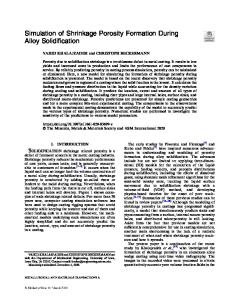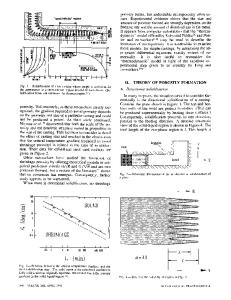Mathematical modeling of porosity formation in solidification
- PDF / 1,416,485 Bytes
- 8 Pages / 614.28 x 794.28 pts Page_size
- 14 Downloads / 413 Views
I.
INTRODUCTION
POROSITY defects such as shrinkage and gas holes are often found in castings. Although there are many reports ~-~ about computer simulation of macroscopic heat flow in castings, these modeling efforts do not predict porosity defects directly. There are some reports 5 8 which do predict the occurrence of shrinkage porosity from the pressure drop during interdendritic fluid flow. However, the effects of gases in solidifying metals have not been considered satisfactorily. In fact, formation of shrinkage porosity and gas holes in separate locations is rare. and when conditions for both to form exist, they occur simultaneously at the same place. In the present work, porosity formation in solidifying alloys is calculated numerically and includes consideration of shrinkage and gas evolution. The computer simulation should improve the capability of producing sound castings.
II.
CONCEPT OF POROSITY FORMATION
Schematic representation of a possible feeding mechanism proposed by Campbell 6 is shown in Figure 1, where four types of feeding are illustrated. The first is liquid feeding which occurs at the initial stage of solidification. The second is mass feeding which may occur, but is not well understood. The third is interdendritic feeding which occurs at a later stage of solidification and may have direct effects on formation of porosity defects. The fourth is solid feeding which occurs at the last stage of solidification and is related to distortion of castings. Porosity defects are caused by the limitations of these feeding mechanisms. Since the resistance to liquid feeding and mass feeding are small because they occur at low solid fraction, interdendritic feeding is considered to be the most important stage for creation of porosity defects. In this paper, porosity formation is analyzed only during the interdendritic feeding regime.
KIM10 KUBO is Visiting Assistant Research Scientist on leave from Osaka Umvers~ty, Osaka, Japan ROBERT D PEHLKE is Professor. Department of Materials and Metallurgical Engmeenng. University of Michigan, Ann Arbor, MI 48109 Manuscript submitted August 29, 1984.
METALLURGICAL TRANSACTIONS B
~
"
IOUlO FEEOIN
"
INERDENDRTIC
FEEDING
"MASS FEEDING
SOLID FEEDING
Fig, l--Schematic repre~entation of possible feeding mecham~ms by Campbell "
Typical examples of porosity in castings of AI-4.5 pct Cu and Cu-8 pct Sn are shown in Figure 2. In A1-4.5 pct Cu round porosity defects are observed between secondary dendrite arms and at grain boundaries. In Cu-8 pct Sn dispersed small pores are found at the roots of the secondary arms, and continuous porosity is found at grain boundaries. These types of porosity are considered to form not only by lack of interdendritic feeding, but also by gas rejection into the liquid during solidification. The growth process of porosity formation is illustrated schematically in Figure 3. At first, gas porosity nucleates at the roots of the secondary dendrite arms as shown in Figure 3(a). The free energy change on formation of porosity is AG
= V(P
Data Loading...











